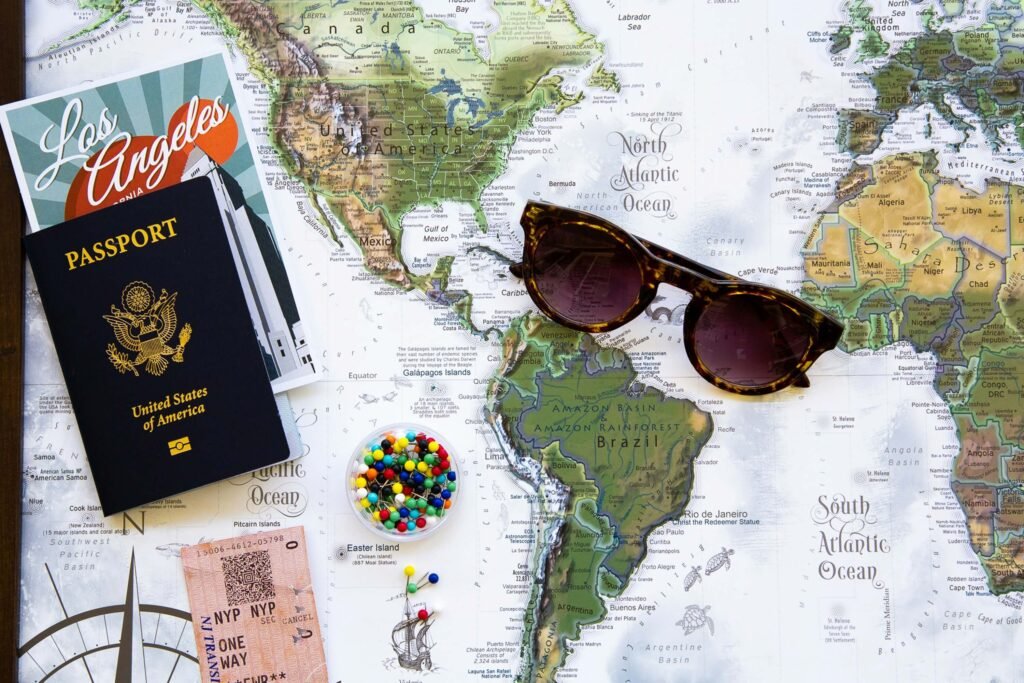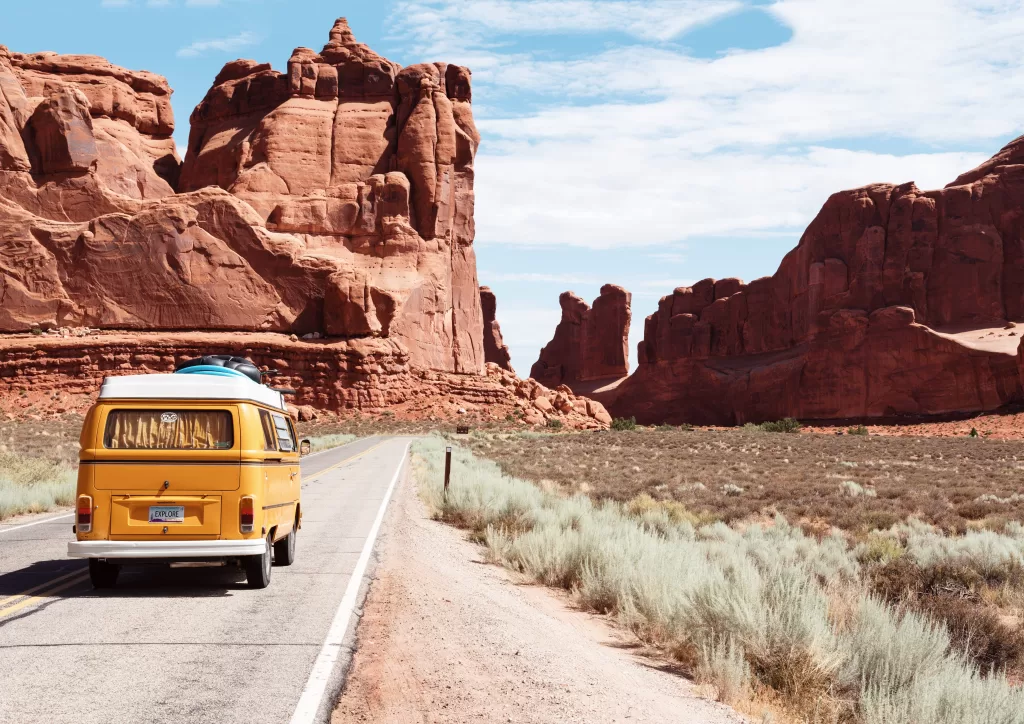Dreaming of a life filled with adventure and new experiences? Welcome to our ‘Your Complete Guide to Becoming a Silver Nomad After 50!‘. Whether you’re ready to embrace the digital nomad lifestyle or just exploring your options, this guide has you covered. We’ll share tips on everything from planning your journey and securing visas to finding remote work and managing your finances. Having lived in three countries and visited over 45, we’ve gathered all the insights and advice you need to make your transition smooth and exciting. It’s never too late to start a new chapter—let’s dive in and discover the freedom and joy of life as a silver nomad!
Table of Contents
Why Consider a Nomadic Lifestyle after Midlife?
For many, midlife can feel like a crossroads. After decades of building a career, raising children, and accumulating possessions, the freedom of a nomadic lifestyle beckons as an exciting way to simplify life and seek new adventures.
As the responsibilities of mortgage payments, carpooling kids, and meetings subside for empty nesters, travel and discovery call. And for those seeking more meaning and purpose in the second half of life, experiential living offers richness. Home can be anywhere for a nomad.
Rather than consigning yourself to a conventional retirement, why not explore exotic lands and cultures? Learn new skills, pursue artistic passions, and volunteer for causes you care about. Embrace minimalism and live out of a backpack, immersing yourself in each destination.
A nomadic life also brings the thrill of the open road. With the right mindset, money saved, and research done, you can traverse the globe on your own terms, not beholden to anyone. Revel in close encounters with nature and magical moments meeting locals. Discover just how rewarding the journey can be.
Tired of the same old routine and thirsty for vibrancy, it may be time to sell or rent out your house, quit your job, and plot an exciting new course as a midlife nomad. Experience is the best teacher—the adventure of a lifetime awaits those daring to seize it.
How to Transition to a Nomadic Lifestyle
Making the transition to a nomadic lifestyle takes thoughtful preparation, especially if you decide to become a nomad later in life. Here are some key steps to help you make the shift:
Save Up Funds
- Start setting aside money well in advance of your planned transition date. Experts suggest having at least 6 months of living expenses saved as an emergency cushion before hitting the road.
- Look for ways to trim your current monthly budget and bank the savings. Reducing housing, transportation, shopping and discretionary spending costs can free up more funds.
- Downsize and sell unneeded possessions. Use the proceeds to pad your travel savings.
Downsize Your Possessions
- Take stock of your belongings and pare down to just essentials you can fit in a vehicle, RV or storage unit. This lightens the load physically and mentally.
- Sell, donate or gift household goods, furniture, recreational gear, specialty clothing items and decor you won’t absolutely need on the road. This further minimizes belongings.
- Scan/digitize documents and photos to store electronically versus physically. Shrink your paperwork down to critical items.
Secure Remote Income
- Research remote work, freelance gigs or online businesses you can operate anywhere with an internet connection. Build up this income stream while still employed.
- Explore passive revenue sources like rental property, eBooks, affiliate marketing, dropshipping and investments that can provide nomadic income.
- Utilize retirement accounts or pensions. Withdrawals and/or distributions can supplement travels.
Finalize Logistics
- Address license renewals, mail forwarding, auto registration, health insurance and other logistics for living mobile.
- Ensure your passport is current. Obtain any required visas for planned destinations.
- Arrange a trial run of nomadic living for a set timeframe. This allows testing of the lifestyle before fully committing.
With the proper preparation, you can make a smooth transition to the nomadic life.
Best Places to Travel as a Nomad

Many retirees and midlife career changers dream of traveling the world as a nomad. With some preparation, this lifestyle is more achievable than you may think. Choosing affordable destinations with pleasant weather, good infrastructure, and ample activities can make being a nomad after midlife more enjoyable. Some top places to consider for nomadic travel include:
- Thailand – With its tropical climate, low cost of living, and abundance of sights and activities, Thailand remains a perennial favorite for nomads. The culture is very hospitable to tourists, infrastructure is good, and visa rules are flexible. With stunning beaches, mountain villages, temples, and bustling cities like Bangkok, Thailand offers something for everyone.
- Mexico – Mexico draws many nomads with its warm weather, coastlines, colonial towns, Maya ruins, and endless culture. Costs are low, especially away from resort areas. Large expat communities provide support. Mexico offers easy access for North Americans. Consider areas like San Miguel de Allende or the Yucatan coast.
- Portugal – For Europe on a budget, Portugal has exploded in popularity with nomads. Lisbon and Porto offer old-world European charm at affordable prices. The Algarve region has stunning beaches and seaside towns. Portugal has a sunny Mediterranean climate and a relaxed, laidback vibe.
- Ecuador – With its low costs, year-round springlike weather, and diversity of landscapes, Ecuador is on the radar for many nomads. Explore the culture of Quito, beach villages, Amazon rainforest, and the Galapagos Islands. Ecuador offers great bang for your buck.
- Vietnam – Loaded with history, culture, beaches, mountains, and delicious cuisine, Vietnam is an intriguing choice for nomadic living. Costs are remarkably low, and you can explore at your own pace. Slow travel through Hanoi, Ho Chi Minh City, Hoi An, and beyond.
Ways to Earn Income While Traveling
One of the biggest concerns when transitioning to a nomadic lifestyle is figuring out how to earn an income on the road. Thankfully, remote work and the gig economy have opened up numerous ways for travelers to support themselves. Here are some of the most popular options:
Remote Work
With the rise of telecommuting, many traditional jobs can now be done remotely. Everything from customer service to software engineering to consulting can potentially be done from a laptop and internet connection. Some companies are fully remote, while others allow remote work a few days a week. Search for “remote” when browsing job boards to find these opportunities.
Teach English
One of the most accessible jobs abroad is teaching English. While a TESOL/TEFL certificate is required, these can be obtained online. Places like Southeast Asia, South Korea, Japan, Eastern Europe etc have schools that will sponsor visas for native English speakers. Pay can range from $15-30 USD per hour.
Freelance Your Skills
Freelancing has become a huge market, with platforms like Upwork, Fiverr, and Freelancer allowing access to global clientele. Skills like writing, design, coding, consulting, and more are in high demand. While competition can be stiff for gigs, building a profile and specializing can help land repeat work.
The freedom of location independence is a dream for many. Thankfully technology and changing work norms have made earning a remote living achievable. With a little strategizing and hustle, funding the nomadic dream is very possible.
Cutting Costs on the Road

One of the biggest concerns when transitioning to a nomadic lifestyle is how to make it financially sustainable long-term. The good news is there are many ways to cut costs and make nomadic living affordable, even on a modest budget. Here are some top strategies:
Slow Travel
- Avoid rushing from place to place. Slow down and stay in each destination longer—at least 1-2 weeks. This avoids constant travel costs and gives you time to take advantage of free attractions.
- Consider house sitting, volunteering, or working in exchange for free accommodations. This slashes housing costs.
- Stick to a simple routine in each place with low-cost activities like hiking, cooking your own meals, and reading books/exploring neighborhoods.
- Travel off-season when prices are lower.
House Sitting
- House sitting has exploded in popularity among nomads. Sign up on sites like TrustedHousesitters, HouseCarers, Nomador, and MindMyHouse.
- You’ll get free housing around the world in exchange for taking care of pets, plants, and property. Some house sits even pay a small stipend.
- House sitting provides stability and community connections compared to constant hotel stays.
Credit Card Rewards
- Sign up for travel rewards credit cards that offer signup bonuses, points for spending, and other perks.
- Use the points you earn to cover flights, hotels, rental cars, and other travel expenses. With some strategic spending, you can offset a significant portion of costs.
- Look for cards that don’t charge foreign transaction fees.
- Always pay off balances in full each month. Only charge what you can afford.
Slow travel, house sitting, and credit card rewards are three fantastic ways nomads can cut costs dramatically. With some strategic planning, you can make long-term nomadic living achievable and sustainable. The financial freedom and rewarding experiences are well worth it.
Staying Healthy as a Nomad
One of the biggest concerns when transitioning to a nomadic lifestyle after midlife is maintaining health and wellness on the road. Finding healthcare, getting insurance coverage, and maintaining a healthy diet and exercise routine can be challenging without a permanent home base. However, with some planning and effort, you can stay fit and address any medical needs that may arise during your travels.
Finding Healthcare
- Research doctors and medical facilities in your planned destinations. Look for clinics that cater to travelers and expatriates, as they will be most accustomed to treating people passing through.
- Consider travel medical insurance that allows you to see doctors worldwide. Companies like GeoBlue and WorldNomads offer comprehensive plans.
- Use telemedicine services like Teladoc to speak with doctors by phone or video chat. They can diagnose common illnesses, prescribe medications, and refer you to in-person care if needed.
- For dental care, look for mobile dentistry services in areas, or schedule appointments during visits back home.
Getting Insurance
- A travel medical insurance policy will give you health coverage while nomadic. Make sure it includes emergency evacuation services to transport you to quality care.
- For U.S. citizens, you may qualify for international health coverage through MediCare if you continue paying premiums. MediCare typically won’t cover you outside the U.S. for more than 6 months.
- Look into expat insurance plans like Cigna Global and Bupa Global for longer term coverage as a nomad.
Diet and Exercise
- Maintaining healthy eating habits can be tough without a home kitchen. Stock up on nutritious snacks, and choose cooked dishes focused on lean proteins, veggies, and healthy grains.
- Stay active through exercise like jogging, bodyweight training at parks, swimming, yoga, and hiking. This will keep your energy and mobility up.
- Combat stress with calming practices like meditation, deep breathing, and journaling. As a nomad, it’s critical to manage stress and anxiety.
- Get regular checkups for preventative care. Have routine bloodwork, cancer screenings, and vaccinations done annually.
With attentiveness to your healthcare needs, insurance coverage, diet, and fitness, you can stay healthy and vital when embracing the nomadic lifestyle. Don’t let potential health obstacles discourage you from pursuing your travel dreams.
Avoiding Loneliness/Isolation
Being a nomad offers incredible freedom and new experiences, but the transient lifestyle can also lead to feelings of loneliness. To avoid isolation on the road, be proactive in ways to regularly connect with others.
Travel Communities
- Seek out nomad meetups in the cities you visit. Sites like Meetup.com list local groups related to remote workers, solopreneurs, and digital nomads. Attend a few meetups to form new connections.
- Look into house sitting opportunities, as this allows you to integrate into a neighborhood. Be open about your nomadic situation so you can meet locals.
- Co-living spaces offer built-in community with other location independent workers. These shared homes or complexes let you make instant connections.
- Consider volunteering locally. This helps you give back, learn about regional culture, and bond over shared goals.
Coworking Spaces
- Coworking spaces function as hubs for nomads to work and network. The communal environment fosters natural conversations to learn from others.
- Attend coworking events to form meaningful relationships. Things like lunch-and-learns, happy hours, member spotlights help you open up.
- See if your workspace offers community forums or messaging so you can digitally connect as well. This allows you to stay engaged with members outside of the physical office.
Local Activities
- Introduce yourself to neighbors and merchants you frequent. Letting local businesses get to know you can lead to friendly dialogues during each visit.
- Take niche classes related to your interests, whether that’s cooking, crafts, fitness, languages, music, etc. You can bond over shared hobby enthusiasm.
- Check venues for community bulletin boards advertising local gatherings and talent shares. These encourage you to showcase your own gifts too.
- Explore your new environment with an open, curious mindset. Small talk with people you encounter can uncover charming areas and local tips that make you feel connected.
Top Nomad Gear & Tools
As a nomad after midlife, choosing the right gear, tools, and tech is key to a happy lifestyle on the road. Over the years, I’ve collected a list of essential items that make my nomadic adventures much smoother and safer.
I personally travel with a lightweight backpack from Osprey. They offer amazing suspension systems, durable construction, and can withstand years of travel. Their Talon 22 is a great midsize bag.
Tech & Electronics
A laptop is probably the most vital tool for a nomad, allowing you to work on the road. The Dell XPS line is a great choice for powerful yet portable models.
Other great tech picks:
- iPad – does everything and super lightweight
- Kindle – for your reading pleasure
- GoPro – capture those amazing travel moments
- Portable battery charger – never run out of power
- Noise cancelling headphones
Travel Storage & Organization
Organization is crucial for a well-oiled journey. I love:
- Packing cubes – keep your pack tidy
- TSA-approved locks – secure your pack at hostels
- Passport pouch – protect that all-important ID
Nomad Safety & Health
Necessities to keep you healthy out there:
- Filtered water bottle – always have clean drinking water
- Disinfecting wipes – keep everything clean
- Medical kit with basic meds – just in case
As a nomad, preparation and smart gear makes for a much smoother experience as you travel from place to place. Invest in quality equipment and organization systems and your travels will be all the better for it.
Visas & Documents for Nomads
Travel Visas:
- You must research visa requirements for countries they plan to visit long-term. Some countries limit tourist visas to 30 or 90 days.
- Long-stay and resident visas may allow you to live somewhere for 6 months to a few years. These often require proof of income/savings and health insurance.
Mail Forwarding:
- Use a reputable mail scanning and forwarding service. They scan your mail and forward it to you anywhere in the world. Provides you with a stable mailing address. Some services offer package forwarding too. May charge monthly fees.
Bank Accounts & Payments:
- It’s wise to maintain a US bank account(s) while traveling abroad. Having a US debit card and credit card with no foreign transaction fees can be useful.
- Opening a bank account as a non-resident in another country can be challenging. Many travelers use international money transfer services to access funds abroad.
Bringing Pets Along

Traveling with a pet as a nomad can be incredibly rewarding, but also challenging. While we no longer travel with pets since our beloved furry companions have passed away, we understand the deep bond and joy that comes from having them by your side on your adventures. This guide is here to help you navigate the unique challenges and reap the rewards of traveling with your pet. From pet-friendly destinations and travel tips to essential packing lists and health considerations, we’ll cover everything you need to ensure both you and your four-legged friend enjoy a smooth and happy journey. Let’s embark on this adventure together, paws and all!
Consider these tips when deciding whether to bring your furry friends:
Focus on pet-friendly destinations: In many countries, pets are welcome in outdoor restaurants and cafes, public transport and taxis, and nature areas. Northern Europe is generally very accommodating to pets. Check each location’s regulations on pets before booking travel.
Research mobile vets: Let your normal vet know of your travel plans, and ask for referrals to other vets throughout your route. Keep an eye out for urgent care clinics that serve pets, which can provide quick treatment during an emergency.
Choose safe transportation: For road trips, use a secured crate or carrier in the car and take regular breaks to walk your pet. Air travel involves following precise protocols and fees, so research requirements for pets in-cabin or as cargo ahead of time. Leaving pets at home and hiring house/pet sitters is an alternative.
Conclusion
Embarking on the journey of becoming a silver nomad after 50 is both exciting and empowering. With the insights and tips provided in this guide, you’re well-equipped to navigate the world of digital nomadism. From planning your travels and managing finances to finding remote work and embracing new cultures, you’re ready to turn your dreams into reality.
The road ahead is filled with endless possibilities, offering you the chance to explore the world, make new friends, and create unforgettable memories. It’s never too late to start a new adventure, and with careful preparation and an open mind, you can thrive as a silver nomad.
Embrace the freedom that comes with this lifestyle, knowing that you have the tools and knowledge to make informed decisions and enjoy every step of the journey. Explore with curiosity, live life on your terms, and discover the joy of new beginnings.
Here’s to new adventures, lasting friendships, and the thrill of discovering the world anew. Safe travels and happy nomading!
Plan your trip with ease by visiting our Accommodation and Transportation pages. Discover unbeatable deals for seamless and unforgettable adventures!
